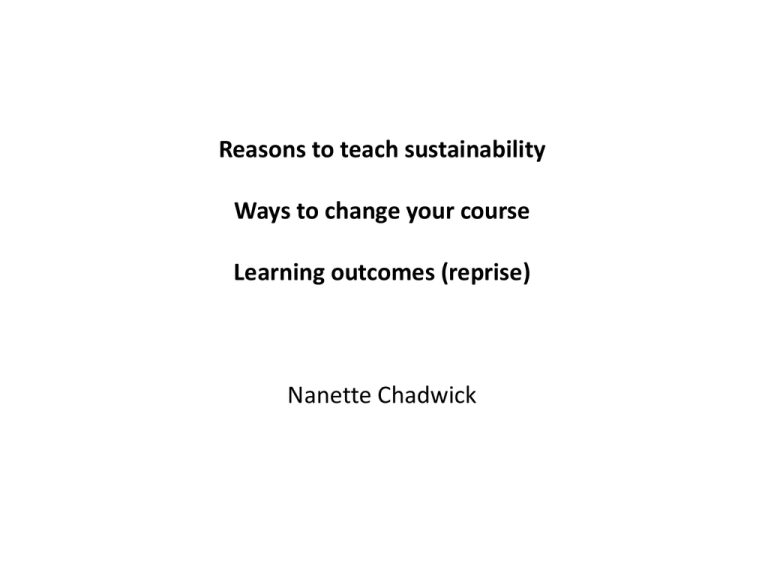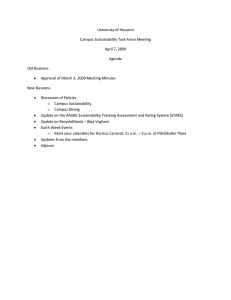Reasons to teach sustainability Ways to change your course Learning outcomes (reprise)
advertisement

Reasons to teach sustainability Ways to change your course Learning outcomes (reprise) Nanette Chadwick Interconnectedness among systems Why teach sustainability? Importance = ever-increasing (world economics, climate change, social issues, health) Understanding = increasing but low Leadership capacity to address = even lower Long ago Now Human History 9 reasons to teach sustainability: Justifying changes to upper admin, peers, students -- Peer inst. are doing (GA Tech, U Georgia, Emory, U Florida, etc.) -- enhances PR and recruitment to AU -- student and employer demand (training for green jobs) -- increases program prestige to upper admin, positive feedback -- increases chances for external funding and awards (Gogue and Univ. presidents climate change award – interested!) -- saves $$ over the long run (millions to utilities & disposal by AU) -- engages the local community and alumni -- enhances interdisciplinary connections and opportunities -- increases depth of understanding by students & quality of education 9 (not another list!) ways to engage sustainability in courses: “Not one more thing to do, but a way to do what you already do.” (1) Hidden curriculum: use as examples/subject matter for class exercises (2) New readings: update/alter to reflect new, integrated sustainability issues (3) Change or add assignments – get students outdoors, on-campus field trips, show a film, youtube videos, TED lectures (4) New unit or module within an existing course – new aspect of subject that relates to sustainability (5) New student project – relevant to student’s lives, new/future social issues (ie: ecological footprint, behavior change challenge) Try Earthscore packet (more long term and in depth, order ahead, $5 per packet) [see on web first!] (6) Invite a guest speaker/add a co-instructor – don’t try to be the expert on all things sustainable! Invite faculty/staff from outside your department – resources of the office (7) Develop a whole new course –put together ideas from several faculty for an interdisciplinary course. Ie: water, food, or energy course that examines ecology, sociology, and politics. (8) Change the world view of your course: same course, different strategy and goals -- paradigm shift (9) Engaged learning / community experience: link to a local or campus issue – service learning Beyond your course: Tell students about the Office of Sustainability Inform students about the Minor in Sustainability Studies Campus as a living laboratory Use campus/city operations and systems to give students hands-on, local experience with real-world sustainability issues: Water – campus & arboretum tours, self- or group-guided Food – campus food gardens, food service systems Transportation – solar to electric cars, bicycles, pedestrians, parking & cars Buildings and energy – Building Science LEED tour, solar house Community programs: food bank, day care center, churches, city government How to incorporate (minimal to maximal): -- extra credit assignment/opportunity – do on their own, turn in proof -- required course homework assignment – do on own, graded -- class field trip or group exercise – guided, on class time -- focus for class project or term paper – intensive involvement of instructor Example: Zanzot course and “Landscape interventions” PM Creek, Bike path Systems thinking tools Iceberg model [see handout] (1) Behavior/Actions What trends relate to an event or issue? Behavior over time graphs (BOT) Example: Walkability of Auburn (flipchart) (2) Underlying causes What causal structures explain these trends? What are the long-term effects of these trends? Any feedback loops? Positive or negative? Causal Loop Diagrams (CLD) (3) Mental models What beliefs/assumptions/mental models perpetuate these trends? Learning outcomes exercise (Reprise) Small groups of 4-5 faculty from different disciplines identify (45 mins): (1) 3-5 broad learning outcomes related to sustainability: What do students need to know? What should they be able to do? (2) Mechanisms to measure outcomes: How do we know what students have achieved, what they now know and can do? (3) How to use or disseminate the evidence: How to use these measures to improve and revise course goals? Individual work (10 mins): Identify 1-2 outcomes in the course you are revising, that will help students achieve broader outcomes determined by the group.
